-
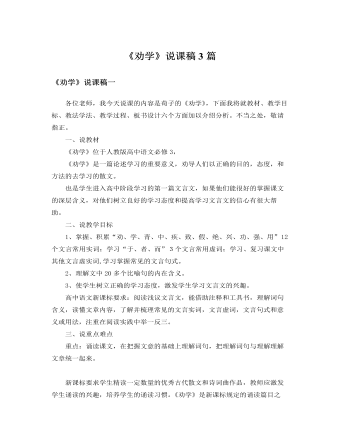
人教版高中语文必修3《劝学》说课稿3篇
《劝学》是普通高中课程标准试验教科书语文必修三第三单元的重点篇目,该文集中反映著名思想家荀子在学习问题上的观点和精彩斐然的论证艺术。该单元所选课文都是古代的议论性散文。通过本单元的学习在于让学生感受我国传统文化的精神,掌握基础的文言语法知识,学习如何清晰有力的表达自己的思想和见解。本文安排在单元的第一篇,如何指导学生学好这篇课文,是实现“授之以渔”,树立学生学好文言文的信心,掌握文言学习方法的关键。根据新课标倡导从“知识与能力”、“过程与方法”、“情感态度与价值观”三方面出发设计课程目标的要求和高一的学生对于文言文的知识还在积累的阶段,应该注重基础知识的积累和一定量的诵读的实际情况。我拟确定以下教学目标:1,了解荀子论述学习的思想,明确学习要靠积累、坚持不懈、专心致志的道理。2,掌握积累文言实词、虚词,活用、古今异议等现象和固定句式。

人教版高中英语必修4Body Language说课稿4篇
Textbook: Senior English for China (Book 4), by Liu Daoyi Time Allotment: 1 period (40 minutes)Date: March 20, 2014Teaching aids: blackboard, Multi-media, Power Point, chalk I. Text Analysis (教材分析)This unit is about body language, and the text selected in the reading part demonstrates the difference and similarity of body language in many parts of the world. Through learning this passage, students are required to raise their awareness of using body language in different parts of the world. As body language is closely related to our daily life, it is easy to arouse students’ interest in learning this text. Reading skills and speaking training are designed around the text.II. Teaching Objectives (教学目标)By the end of the lesson, students will be able to:1. Language Skill Objective(语言技能目标): develop reading ability (skimming and scanning)as well as speaking ability.2. Cultural Knowledge Objective(文化知识目标): know about the cultural differences of using body language.3. Affective Objective(情感目标): increase students’ awareness of using body language correctly in different cultures. III.Teaching Focuses and Difficulties(教学重点和难点)1. Teaching Focuses(教学重点): the difference and similarity of body language in many parts of the world.2. Teaching Difficulties(教学难点): develop students’ reading abilities of skimming and scanning and ask the students to show their opinions with fluent English.

人教版高中英语必修1Nelson Mandela--A Modern Hero说课稿
In this step, give students a few minutes to read the passage . While they are reading, I will write some key words of the text on the blackboard. Then ask students to retell the passage according to the key words.By retelling, students can improve their ability of language organization and have an overall understanding of the article.Step 4 Group discussionIn this step, students will be divided into groups of 4 to discussion the following question: What qualities make a great person?After their discussion, invite a few groups to make a report to the class.This group discussion can practice students’ oral English and cultivate their abilities of cooperation and communication.Step 5. HomeworkLet students write a short passage to introduce a great person he or she admires.The homework can consolidate the knowledge the students have learned and cultivate their writing ability. Part 6 Blackboard Design(板书设计)That’s all my teaching procedures. Finally, I’d like to say sth about part 6 blackboard design. On the top is the title. On the left, there will be some new words and expressions. In the middle of the blackboard, I will write some useful sentence structures so that the students can know clearly what they’ve learned and then try to master the knowledge.OK. That’s all for my presentation. Thank you for your attention.

人教版高中英语必修2Cultural Relics说课稿2篇
Ⅲ. Analysis of the teaching material:The topic of this unit is cultural relics. Students are quite interested in topics about different cultures around the world. This is the second period of the whole unit. As a reading class, the passage mainly talks about the history of the amber room (how it was made, sent as a gift, lost and rebuilt).According to the new national curriculum, when teaching reading, much emphasis should be put on training the students’ reading skills.Ⅳ. Teaching objectives1. Language objectives:1) Students are required to master the key words and phrases occurred in the passage (e.g. amazing, decorate, belong, in return, less than etc.)2) Students are required to learn the attributive clause and acquire the sentence pattern.2. 1) Students are required to describe a certain thing by using the new sentence patterns.2) Students are required to master two kinds of reading skills—skimming and scanning, and learn to use them in their daily reading.3. 1) Students are required to know the history of the amber room.2) Students are required to appreciate cultural relics and understand the importance of protecting them.Ⅴ. Teaching important and difficult points1) the new words, phrases, and sentence pattern in the course of reading.2) Teaching difficult point: Help the students master two kinds of reading skills—skimmingand scanning and learn to apply them in daily use.Ⅵ. Teaching methods:Task-based method & Top-down model Ⅶ. Teaching aids: PPT, pictures, blackboard Ⅷ. Teaching procedure:

人教版高中英语必修3Astronomy the science of the stars说课稿3篇
Step 2 Pre-listeningAfter students finish their discussion, I will show a picture of Newton and ask them: Who is him? What is he famous for? Could you find out some words to describe him? Maybe students will answer that he is genius for his finding of theGravitation, making a great contribution to the progress of human being. At that time I will show another two pictures of Einstein and Hawking, letting students guess who they are and write down their idea about the Gravitation. For I have arranged them to search more information about the gravity before this class, Students have beenfamiliar with the topic and will not be afraid about this abstract conception, which is helpful for their listening.Step 3 While-listeningIn this step, students will be required to listen the material for three times. The first and listening is extensive listening and the second and third listening is intensive listening. In the first time, They are required to listen a material including Part 1 and Part 2 and choose the best summary of the listening text. After they choose the right answer, They also need work in group to explain what is wrong with the others. Then I will make a conclusion that we should pay attention to the first paragraph and last paragraph and some keys to get the main idea. By doing this, their capacity of generalization will have a great improvement.Before the second listening, I will ask students to scan the blank on the power point quickly and ask them to note down some key words .Then ask them to listen to the Part 1again and fill the first column of the chart. Maybe some students just show the ideas of these three scientists an still can’t catch their development of gravity. Therefore, I will ask them to listen to Part 2 again and fill in the rest. After finish the listening, I will give them ten minutes to discuss with their partner. I will also guidethem to improve their answers when they discuss with others.

人教版高中英语必修3Canada-the true north说课稿4篇
Good afternoon, teachers, It’s my great pleasure to be here sharing my lesson with you.The content of my lesson is Senior English Book 3 Unit 5 Canada —— “The true North”.I’ll be ready to begin this lesson from five parts. Analysis of the teaching material,the teaching methods,the studying methods, the teaching procedure,and Blackboard design.First, let me talk about the teaching material.Part 1 Teaching Material:This unit is about the introduction of Canada. By studying of this unit,we’ll enable the students to learn the geography, population, main cities, and natural beauty, natural resources of Canada. Through the training of the unit, it also requires students to learn some Language skills such as the expressions of position and emotions.So it plays an important part in the English teaching in this book.After studying the teaching material and analyzing the rule of children’s growing of mind,I think the teaching aims are the followings:1.Knowledge objects:(1) make the students learn some new words and phrases(2) make the students understand the content of the lesson.2.Ability objects:(1)To develop the Ss’ abilities of listening, speaking, reading and writing. Especially reading and speaking ability.(2) learn to talk about the characters of Canada in English(3)To train the Ss’ ability of working in pairs.3.Emotion objects:(1)Enable students to understand the characters of Canada..(2)Stimulate Ss to work hard to make China stronger.Part 2 Teaching Methods:I think helping students learn to master new words and phrases and improve the students’ reading and speaking ability is import and the difficult.According to the analysis of the teaching material and the import points and the difficult points,I will use the following teaching methods : question-guiding approach; fast-reading and careful reading; multi-media teaching methods; discussion

人教版高中英语必修3Festivals around the World说课稿3篇
Teaching plan for Unit 1 book3Good morning, teachers. It’s my great pleasure to be here because I can share my lesson with you and I can learn a lot from it. I’ll begin my lesson from the following four parts, the teaching material, the teaching methods, the studying methods and the teaching procedure.Firstly, let me talk about the teaching material. The content of my lesson is the reading passage festivals and celebrations of Unit 1 Festivals around the world. This passage is about festivals and celebrations. By studying this passage, we’ll enable the students to know that festivals exit everywhere, and many of festivals in different countries celebrate similar ideas. As we all know, the reading passage is the center of each unit. If the Ss can learn it well, it will be helpful to make the Ss learn the rest of this unit.After studying the teaching material, I think the teaching aims are as the followings:1. Knowledge aims:(1) The Ss can master the usage of the important words andexpressions.(2)The Ss can use the __________________ (grammar) in the proper situation.Make students know about the festivals all over the world and the detail of the festivals, such as origin, content, and the date of the holiday festivals.2. Ability aims:(1) Students can talk about festivals and celebrations in English(2) To improve the student’s reading ability, especially their skimming and scanning ability.3. Emotion aims:Make the Ss know about the foreign festivals, and respect other countries’ custom.Next, let’s come to the important points and the difficult points.The important point is how to make the Ss understand the text better and the difficult point is how can they talk about it. secondly, Teaching Methods:1. task-based Language Teaching2. Computer assisted language teaching.3. question-and–answer methodThirdly, Studying Methods:

人教版高中英语必修4Working The Land说课稿3篇
Knowledge objectives:(1) to make Ss grasp the usage of words, expressions and sentence structures: statistics, struggle, thanks to, rid of, some patterns for persuasion, the “ing” form as subject and object;(2)to use learnt knowledge to persuade sb.Ability objectives:(1) to develop Ss’ reading skills(skimming, scanning, word guessing);(2) to improve Ss’ speaking, communicating and cooperating skills.Emotional objectives:to make Ss know the contribution of Yuan,and learn his spirit and his simple life time.Teaching important and difficult points:(1) some words, expressions and sentence structures mentioned above;(2)the content of the text;(3)training their reading and speaking skills.Teaching methods: CLT, TBLT,QT.Learning strategies: CLS, QLS, TBLS.Teaching procedures:Step 1 lead-in: (1) teacher plays a piece of recent news from CCTV about the harvest of the super hybrid rice, and ask students whether they know Yuan or not, and talk about him and his contribution.(2)Brain storm: let Ss describe Yuan in their minds including his appearance, his living condition and so on.Step 2 fast reading tasks:(1)teacher introduces Yuan and super hybrid rice(2)make Ss read the text as fast as possible with questions. Such as: what’s the general ideaof this passage? What’s Yuan’ dream? (skimming and scanning skill)Step 3 intensive reading tasks(1)let Ss read the text silently, find topic sentence of each paragraph and draw the difficult sentences and the knowledge what they don’t understand.(words guessing)(2)teacher and Ss talk about the important words, expressions and sentences together, and ask Ss to retell the content of the text.(summarizing and paraphrasing)(3)teacher summarize this part.(4) read again following the courseware.

人教版高中英语必修5First aid说课稿6篇
In this class, I have 3 teaching aims, that is, knowledge aims, ability aims and emotion aims.1) Knowledge-Teach students new words and expressions, such as temporary, bleed,sprain choke, first aid, fall ill and so on.-Enable students to have a better understanding for some basic knowledge of first aid.2) Ability-Train students’ speaking, reading and writing abilities by different teaching activities, such as skimming, comprehending, team work, role play, retelling and writing.-Develop students’ reading strategy on how to move general idea to specific information.3) Emotion-Promote students’ awareness of giving first aid.- Cultivate students’ creativities.Then let’s come to my teaching methods and activities.III. Teaching methods and activities:To achieve different teaching aims, various kinds of teaching methods and activities will be adopted throughout this period, such as TBL (task-based learning), skimming, team work, brainstorm and others, which can offer students opportunities to fulfill tasks in which they can use language to achieve a specific outcome.IV. Teaching aids:Computer and blackboardV. Teaching important points:1) Make students have a clear mind for the structure of the text.2) Help students understand the theme of the text.VI. Teaching difficulties:1) So many new words may affect students’ understanding.2) How to get students to know about the functions of the skin and thecauses, characteristics and treatments for different degree burns,and the knowledge about giving first aid. VII. Blackboard design:

人教版高中英语必修5Making the news说课稿4篇
今天我们来介绍一下必修五第四单元的授课方式。这个单元的题目是Making the news。应该是学生比较感兴趣的话题,学生往往对新闻工作充满好奇,所以我们可以利用这个机会多设计一些师生互动和学生互动,来激发起学习的积极性,提高学习效率。同时我们可以利用这个单元不仅帮助学生掌握语言知识,培养语言能力,同时让其了解新闻工作的重要性,培养起社会智能感。这个单元分为六个课时,它的教学目标是这样的:语言目标是掌握词汇表中的常用单词和短语,掌握倒装句的一些基本用法。 技能目标是能初步掌握约会的基本句型并在真实的场景下正确运用。新闻报道类文章的写作技能。采访的基本规范和沟通技能。情感目标是对新闻报道的客观性和真实性有更好的理解。对新闻记者的职业有更深入的了解,并能体会其工作的重要性。下面我们来介绍一下第一课时的授课方式,第一课的教学目标是这样的第一课时的教学目标语言目标:单词:Occupation, journalist, editor, photographer, curious, personality, enthusiasm
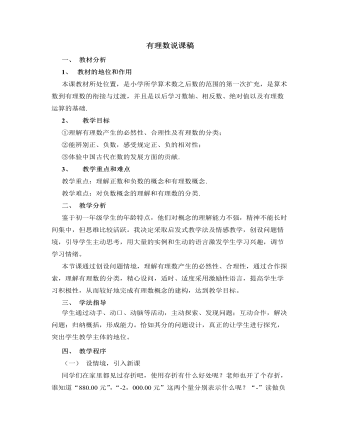
北师大初中数学七年级上册有理数说课稿
1、 教材的地位和作用本课教材所处位置,是小学所学算术数之后数的范围的第一次扩充,是算术数到有理数的衔接与过渡,并且是以后学习数轴、相反数、绝对值以及有理数运算的基础.2、 教学目标①理解有理数产生的必然性、合理性及有理数的分类;②能辨别正、负数,感受规定正、负的相对性;③体验中国古代在数的发展方面的贡献.3、 教学重点和难点教学重点:理解正数和负数的概念和有理数概念.教学难点:对负数概念的理解和有理数的分类.二、 教学分析鉴于初一年级学生的年龄特点,他们对概念的理解能力不强,精神不能长时间集中,但思维比较活跃。我决定采取启发式教学法及情感教学,创设问题情境,引导学生主动思考,用大量的实例和生动的语言激发学生学习兴趣,调节学习情绪。
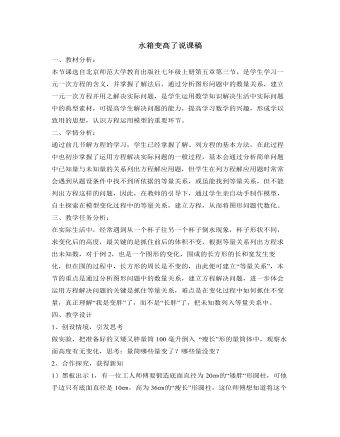
北师大初中数学七年级上册水箱变高了说课稿
一、教材分析:本节课选自北京师范大学教育出版社七年级上册第五章第三节,是学生学习一元一次方程的含义,并掌握了解法后,通过分析图形问题中的数量关系,建立一元一次方程并用之解决实际问题,是学生运用数学知识解决生活中实际问题中的典型素材,可提高学生解决问题的能力,提高学习数学的兴趣,形成学以致用的思想,认识方程运用模型的重要环节。二、学情分析:通过前几节解方程的学习,学生已经掌握了解、列方程的基本方法,在此过程中也初步掌握了运用方程解决实际问题的一般过程,基本会通过分析简单问题中已知量与未知量的关系列出方程解应用题,但学生在列方程解应用题时常常会遇到从题设条件中找不到所依据的等量关系,或虽能找到等量关系,但不能列出方程这样的问题,因此,在教师的引导下,通过学生亲自动手制作模型,自主探索在模型变化过程中的等量关系,建立方程,从而将图形问题代数化。
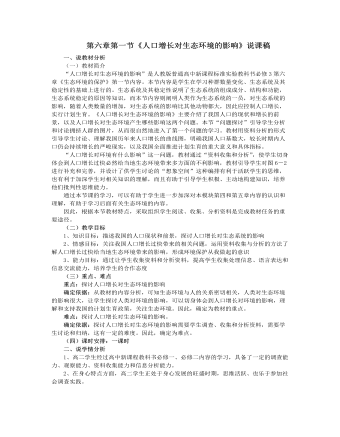
人教版高中生物必修3第六章第一节《人口增长对生态环境的影响》说课稿
3、讨论问题二:我国、我市人口增长对环境有那些影响?教师:让第三、第四组学生分别介绍、展示课前调查到的资料,说明人口增长对我国环境的影响、对三亚市环境的影响。学生:第三组学生派代表介绍人口增长过快对我国生态环境的影响。第四小组由学生自己主持“我市人口增长过快对三亚市生态环境的影响”讨论会,汇报课前调查到的资料和讨论,其它小组参与发言。教师:投影:课本图6-2组织学生讨论、补充和完善。学生:观察老师投影图片并进行讨论,对图片问题进行补充和完善。教学意图:通过让学生汇报、观察、主持,能让学生亲身体验,更深刻地理解人口增长对生态环境的影响,培养和提高学生的表达能力、观察能力、主持会议的能力。4、讨论问题三:怎样协调人与环境的关系?教师:组织第五组学生进行汇报课前调查到的资料,交流、讨论、发表意见和见解。学生:展示课件、图片,汇报调查到的情况,提出合理建议。
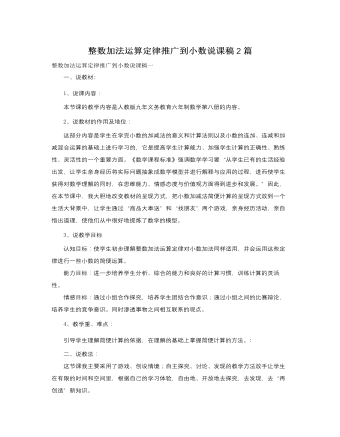
人教版新课标小学数学四年级下册整数加法运算定律推广到小数说课稿2篇
1.揭示课题那么,这个运算定律是否对分数加法也适用呢?现在我们就来研究这个问题。板书课题:整数加法运算定律推广到分数加法。2.研究运算定律对分数加法的适用性出示式题:提问:上面每组算式的左右两边有什么关系?得数是否相等?先指名学生练习,算出得数后,再引导学生观察。提问:这两组试题有何共同之处?组织学生开展小组讨论,共同概括总结出他们的共同点,得出规律性的认识,从而使学生体会到整数加法运算定律,对分数加法同样适用。通过讨论明确:加法的交换律、结合律中的数,既包括了整数,又包括了小数和分数。【设计意图】通过具体的实践活动,直观感知了加法运算定律同样也适用于分数加法。这种通过自己实践得来的东西,学生理解得更透,掌握得更牢。
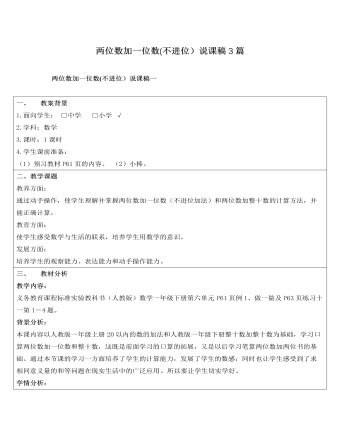
人教版新课标小学数学一年级下册两位数加一位数(不进位)说课稿3篇
一、说教材《两位数加一位数的进位加法》是人教版义务教育课程标准实验教科书一年级下册P62“两位数加一位数的进位加法”,本课是在两位数加一位数和整十数的基础上进行教学的。在本节课中,通过生活情境图,引入两位数加一位数的进位加法,并使学生在解决实际问题的过程中,进一步体会加法的意义,鼓励学生提出问题并解决问题,要让学生在独立思考的基础上,经历与他人交流的过程,探索并掌握两位数加一位数进位加法的计算方法,并能正确地计算,加强动手操作,探索计算方法,体会算法的多样性。根据本节课在教材中的地位和作用,依据小学数学课程标准和孩子们已有的认知水平,我把本节课的教学目标定为:1、知识与技能在解决实际问题的过程中,进一步体会加法的意义,探索并掌握两位数加一位数进位加法的计算方法。
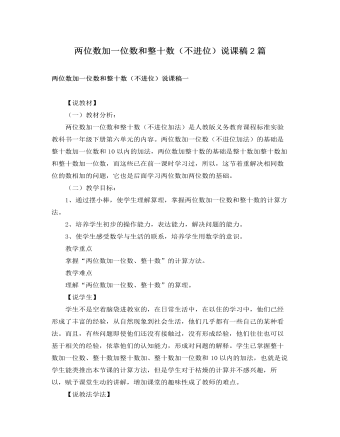
人教版新课标小学数学一年级下册两位数加一位数和整十数(不进位)说课稿2篇
(二)创设情境,探索新知。1、创设情境,激发兴趣。小白兔和小熊要坐公交车去公园,他们来到公交公司,先后看到公交公司有一边说一边课件出示课件,请同学们仔细观察,把你从图上看到的物品和读出的数据告诉老师和其他同学。你能根据这些信息提出不同的数学问题吗?再从同学们提出的众多问题中选择两个具有代表性的问题来列式和计算。课件出示主题图下列两个问题:指名说出两个问题的算式分别是什么,明确45 + 30和45 + 3是两位数加一位数和两位数加整十数的加法算式,引出课题——两位数加一位数和整十数(不进位)这一层次从学生熟悉的生活情境出发,选择学生熟悉的旅游,让学生自己发现、提出有关的数学问题,从而主动的解决问题。这里通过创造出生动的生活情境来提取例题,符合学生的年龄、认知特征,既激发了学生的学习兴趣,又使学生感受到数学与生活的密切联系,容易为学生所感知,所接受。
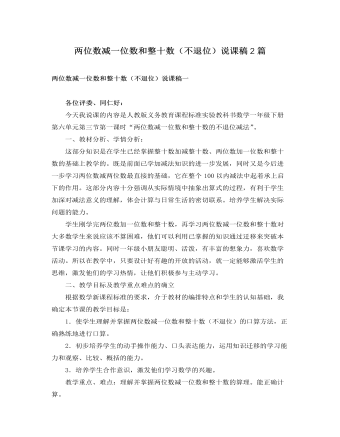
人教版新课标小学数学一年级下册两位数减一位数和整十数(不退位)说课稿2篇
3、教学目标及教学重点难点根据课标的要求,介于教材的特点和学生实际,我确定本节课的教学目标是:(1)、知识与技能:让学生经历探索两位数减一位数和整十数(不退位)的计算方法的过程,掌握计算方法,能正确地口算。(2)、过程与方法:让学生经历自主探索、动手操作、合作交流等方式获得新知的过程,积累数学活动的经验,体会数学知识与日常生活的密切联系,增强应用意识。 (3)、情感态度与价值观:进一步培养学生学习数学的热情,以及积极思考、动手实践并与同学合作学习的态度。其中,掌握两位数减一位数和整十数(不退位)的口算方法是重点,理解算理,把握两位数减一位数与两位数减整十数在计算过程中的相同点与不同点是难点。
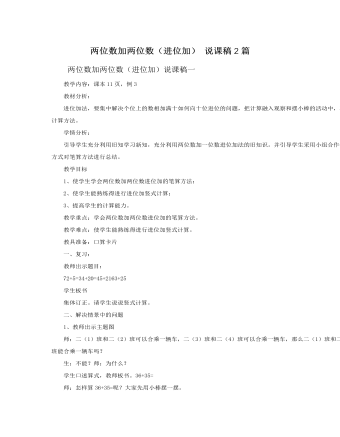
人教版新课标小学数学二年级上册两位数加两位数(进位加) 说课稿2篇
一、说教材:本课时主要的内容就是让学生在情境中掌握两位数加两位数的进位加法计算,让学生通过尝试和探索出多种算法,体验多种算法,然后比较出最好的算法。教学目标:1、通过具体的情境使学生更一步的理解加法的意义和提高学生的估算意识。2、通过学生的合作学习从而能探讨出多种计算两位数减两位退位减法的方法。3、培养学生的数学口语表达能力,提高学生的学习兴趣。4、掌握两位数加两位数(进位加)竖式的写法。重点:(1)通过学生的合作学习从而能探讨出多种计算两位数减两位退位减法的方法。(2)掌握笔算加法的计算法则。难点:对多样化算法进行优化,达到正确完成计算。发展学生的估算意识、和探究意识和解决实际问题的能力。二、说教法:组织学生在前面计算的基础上,自主探索出两位数加两位(进位加)的计算方法,并通过交流、讨论,达到对算法的优化,在通过“试一试”、“算一算”、“想一想”等形式达到知识的掌握。
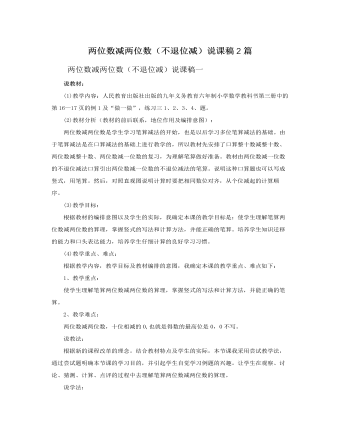
人教版新课标小学数学二年级上册两位数减两位数(不退位减)说课稿2篇
说教材:(1)教学内容:人民教育出版社出版的九年义务教育六年制小学数学教科书第三册中的第16—17页的例1及“做一做”,练习三1、2、3、4、题。(2)教材分析(教材的前后联系,地位作用及编排意图):两位数减两位数是学生学习笔算减法的开始,也是以后学习多位笔算减法的基础。由于笔算减法是在口算减法的基础上进行教学的,所以教材先安排了口算整十数减整十数、两位数减整十数、两位数减一位数的复习,为理解笔算做好准备。教材由两位数减一位数的不退位减法口算引出两位数减一位数的不退位减法的笔算。说明这种口算题也可以写成竖式,用笔算。然后,对照直观图说明计算时要把相同数位对齐,从个位减起的计算顺序。(3)教学目标:根据教材的编排意图以及学生的实际,我确定本课的教学目标是:使学生理解笔算两位数减两位数的算理,掌握竖式的写法和计算方法,并能正确的笔算。培养学生知识迁移的能力和口头表达能力,培养学生仔细计算的良好学习习惯。
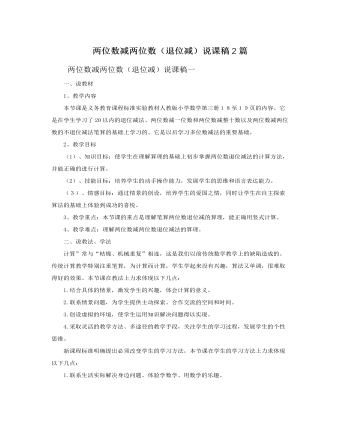
人教版新课标小学数学二年级上册两位数减两位数(退位减)说课稿2篇
一、说教材1、教学内容本节课是义务教育课程标准实验教材人教版小学数学第三册18至19页的内容。它是在学生学习了20以内的退位减法、两位数减一位数和两位数减整十数以及两位数减两位数的不退位减法笔算的基础上学习的。它是以后学习多位数减法的重要基础。2、教学目标(1)、知识目标:使学生在理解算理的基础上初步掌握两位数退位减法的计算方法,并能正确的进行计算。(2)、技能目标:培养学生的动手操作能力,发展学生的思维和语言表达能力。(3)、情感目标:通过情景的创设,培养学生的爱国之情,同时让学生在自主探索算法的基础上体验到成功的喜悦。3、教学重点:本节课的重点是理解笔算两位数退位减的算理,能正确用竖式计算。4、教学难点:理解两位数减两位数退位减法的算理。